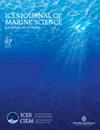Using opportunistic data to study the distribution and abundance of a warm water elasmobranch at the northern edge of its range
IF 3.4
2区 农林科学
Q1 FISHERIES
引用次数: 0
Abstract
Detecting changes in the distribution and abundance of marine species that are cryptic or occurring in very low abundances is difficult, but essential for assessing their status and informing management. One way of quantifying these changes is through the collation of opportunistic records. We reconstruct the population trajectory and distribution of the common stingray Dasyatis pastinaca around Great Britain, using opportunistic records, mostly obtained by recreational anglers. We tested if D. pastinaca declined in abundance and body size in response to fishing and if their distribution has shifted northwards in response to warming seas. We obtained 518 records covering the period 1838–2020. After correcting for observation effort, D. pastinaca catches reported by anglers showed no long-term trend over 50 years, but decreased from 1970 to 1995 and an increase in abundance since 1995. While records of species occurrence were found around much of Great Britain, nearly all were from south of 54° latitude, and records have contracted southwards since 2000. No trend in maximum size through time was detected. In conclusion, we did not find support for the hypothesized declines in abundance and body size or a northward shift in distribution of D. pastinaca and instead found a southward contraction.利用机会数据研究暖水板鳃在其活动范围北部边缘的分布和丰度
探测隐秘或丰度极低的海洋物种的分布和丰度的变化是困难的,但对于评估其状况和向管理部门提供信息至关重要。量化这些变化的一种方法是整理机会记录。我们重建了英国常见黄貂鱼(Dasyatis pastinaca)的种群轨迹和分布,使用机会记录,主要是由休闲垂钓者获得的。我们测试了帕斯提纳鲷的丰度和体型是否因捕捞而下降,以及它们的分布是否因海洋变暖而向北转移。我们获得了518条记录,时间跨度为1838年至2020年。经观测校正后,垂钓者报告的白鳉鱼渔获量在50年内无长期趋势,但在1970 - 1995年间呈下降趋势,1995年以后呈增加趋势。虽然在英国的大部分地区都发现了物种出现的记录,但几乎所有的记录都来自北纬54度以南,而且自2000年以来,记录向南收缩。没有检测到最大尺寸随时间的变化趋势。综上所述,我们没有找到证据支持东方朔的丰度和体型下降或分布向北转移的假设,而是发现南向收缩。
本文章由计算机程序翻译,如有差异,请以英文原文为准。
求助全文
约1分钟内获得全文
求助全文
来源期刊

ICES Journal of Marine Science
农林科学-海洋学
CiteScore
6.60
自引率
12.10%
发文量
207
审稿时长
6-16 weeks
期刊介绍:
The ICES Journal of Marine Science publishes original articles, opinion essays (“Food for Thought”), visions for the future (“Quo Vadimus”), and critical reviews that contribute to our scientific understanding of marine systems and the impact of human activities on them. The Journal also serves as a foundation for scientific advice across the broad spectrum of management and conservation issues related to the marine environment. Oceanography (e.g. productivity-determining processes), marine habitats, living resources, and related topics constitute the key elements of papers considered for publication. This includes economic, social, and public administration studies to the extent that they are directly related to management of the seas and are of general interest to marine scientists. Integrated studies that bridge gaps between traditional disciplines are particularly welcome.
 求助内容:
求助内容: 应助结果提醒方式:
应助结果提醒方式:


